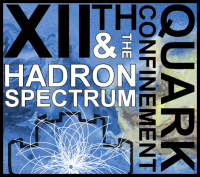Speaker
Description
The QCD vacuum is populated by instantons that correspond to the tunneling processes in the vacuum. This mechanism creates the strong vacuum gluon fields. As result, The QCD vacuum instantons induce very strong interactions between light quarks, which was initiall almost massles. Such strong interactions bring about a large dynamical mass $M$ of the light quarks and can bound them to produce almost massless pions in accordance with the spontaneous breaking of chiral symmetry ($S\chi$SB). On the other hand, the QCD vacuum instantons also interact with heavy quarks and responsible for the generation of the heavy-heavy and heavy-light quarks interactions, which has a traces of the $S\chi$SB (see [1] and references therein). If we take the average instanton size $\rho=$0.35 fm, and the average inter-instanton distance $R=0.856$ fm from our previous estimates, we obtain at leading order in the $1/N_c$ expansion the dynamical light quark mass to be $M = 570$ MeV and the instanton media contribution to the heavy quark mass $\Delta M$=148 MeV. These factors define the coupling between heavy-heavy and heavy-light quarks induced by the QCD vacuum instantons.
We consider first the instanton effects on the heavy-quark potential, including its spin-dependent part. We also discuss those effects on the masses of the charmonia and their hyperfine mass splittings [1].
At the second part of the present talk, we discuss the interactions between a heavy quark and light mesons in the case of the light quark flavor number $N_f=2$ case [2].
[1] U. Yakhshiev, Hyun-Chul Kim, B. Turimov, M.M. Musakhanov, Emiko Hiyama, Instanton effects on the heavy-quark static potential, [arXiv:1602.06074 [hep-ph]].
[2] M. Musakhanov, Heavy-light quarks interactions in QCD vacuum, PoS BaldinISHEPPXXII {\bf } (2015) 012 [arXiv:1412.4472 [hep-ph]].
